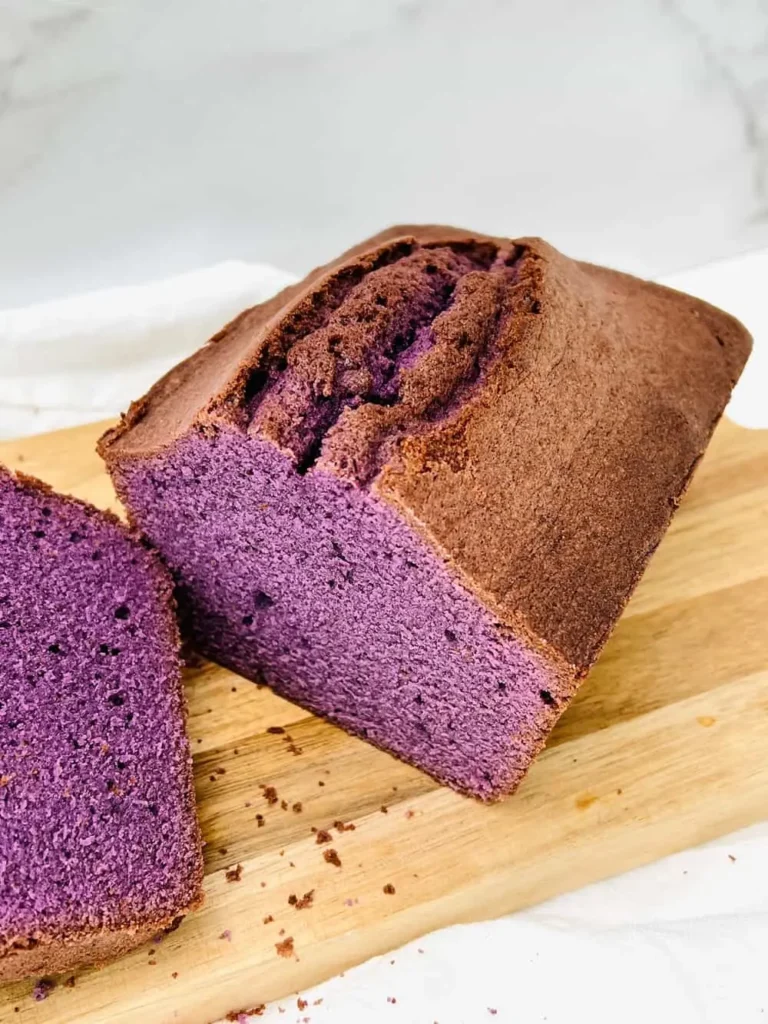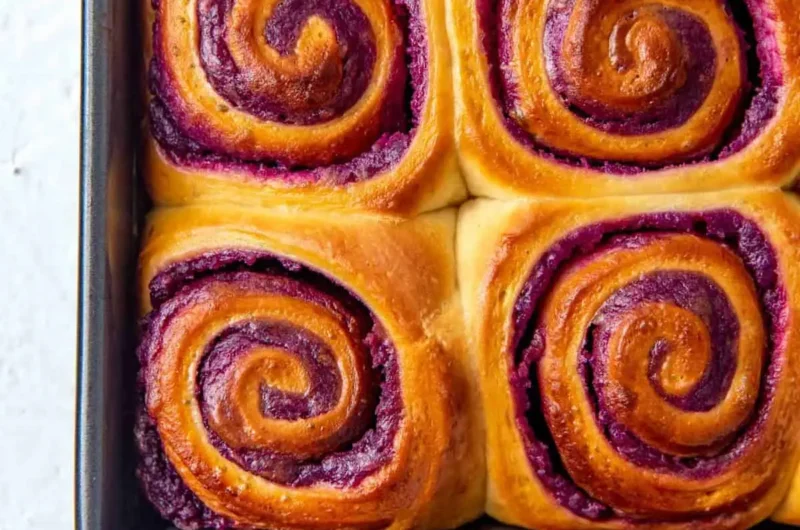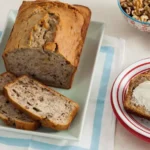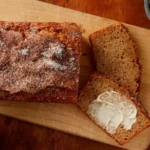Are you tired of the same old bread recipes? Looking for something unique and delicious to satisfy your cravings? Well, look no further because today we’re going to introduce you to the world of Ube Bread.
This vibrant purple bread is not only visually appealing but also incredibly tasty. Imagine sinking your teeth into a soft, fluffy loaf with a hint of sweetness that comes from the natural flavor of ube.
Intrigued? Stay tuned as we guide you through the steps of this irresistible Ube Bread recipe that will surely leave you wanting more.

Contents
- 1 Key Takeaways
- 2 Ingredients for Ube Bread
- 3 Preparing the Ube Puree
- 4 Mixing the Dough
- 5 Proofing and Shaping the Bread
- 6 Ube Bread Recipe
- 7 Baking and Enjoying the Ube Bread
- 8 Nutrition facts
- 9 Frequently Asked Questions
- 9.1 Can I Use Frozen Ube Instead of Fresh Ube for the Bread Recipe?
- 9.2 How Long Does It Take for the Dough to Double in Size During Proofing?
- 9.3 Can I Substitute the Bread Flour With All-Purpose Flour for This Recipe?
- 9.4 How Long Should I Let the Bread Cool Before Slicing and Serving?
- 9.5 Can I Freeze the Ube Bread for Later Consumption?
- 10 Conclusion
Key Takeaways
- Ube Bread is a unique and delicious bread recipe that is visually appealing with its vibrant purple color.
- Ube, also known as purple yam, is the star ingredient in Ube Bread and is a popular ingredient in Filipino cuisine.
- Ube is not only flavorful but also rich in vitamins, minerals, and antioxidants.
- Preparing Ube puree is essential for infusing the bread with the rich flavor of purple yam and can be used in various other recipes.
Ingredients for Ube Bread
To make delicious Ube Bread, you’ll need a specific set of ingredients that will bring out the vibrant flavors and beautiful purple color. Ube, also known as purple yam, is the star ingredient in this bread recipe. It’s a popular ingredient in Filipino cuisine and is known for its unique taste and stunning color.
There are different variations of Ube Bread, but the basic ingredients remain the same. You’ll need all-purpose flour, sugar, yeast, salt, milk, eggs, butter, and of course, Ube. Ube can be obtained in various forms such as powder, extract, or fresh yam, depending on your preference.
In addition to its delightful taste, Ube also offers several health benefits. It’s rich in vitamins and minerals, including vitamin C, potassium, and fiber. Ube is also known for its antioxidant properties, which can help boost your immune system and protect against certain diseases.
Preparing the Ube Puree
To create the perfect Ube puree for your bread, you’ll need to transform the vibrant purple yam into a smooth and velvety consistency that will infuse the bread with its rich flavor.
Ube, also known as purple yam, is a versatile ingredient that can be used in a variety of recipes, adding a unique and vibrant color to your dishes. Apart from its stunning appearance, ube also offers numerous health benefits.
It’s rich in antioxidants, which help protect your body against free radicals and reduce the risk of chronic diseases. Ube is also a good source of fiber, which aids in digestion and promotes a healthy gut. Additionally, it contains essential vitamins and minerals like vitamin C, vitamin A, potassium, and calcium.
To prepare the Ube puree, start by washing and peeling the yam. Cut it into chunks and steam until tender. Once cooked, transfer the yam to a blender or food processor and blend until smooth. If needed, you can add a small amount of water to achieve the desired consistency.
Now that you have your velvety Ube puree, you can use it in various recipes, such as Ube cupcakes, Ube ice cream, or Ube pancakes. Get creative and enjoy the delightful flavors and vibrant colors that Ube brings to your culinary creations.
Mixing the Dough
Now it’s time to mix the dough and bring all the delicious ingredients together.
To create the perfect dough consistency, you’ll need to employ some expert kneading techniques. This process won’t only help develop the gluten in the dough but also ensure a light, fluffy texture in your Ube bread. Here are some key tips to help you troubleshoot any issues with the dough consistency:
- Slow and Steady: Start by combining the dry and wet ingredients in a large bowl. Gradually add the dry mixture to the wet mixture, stirring slowly and steadily. This will ensure that all the ingredients are evenly incorporated and prevent any lumps from forming.
- The Gentle Touch: When kneading the dough, use a gentle touch. Push the dough away from you with the heel of your hand, then fold it back towards you. Repeat this motion, gradually adding more flour if needed, until the dough becomes smooth and elastic.
- The Windowpane Test: To check if the dough is well-kneaded, perform the windowpane test. Take a small piece of dough and stretch it gently between your fingers. If it stretches thin enough to let light pass through without tearing, your dough is ready.

Proofing and Shaping the Bread
After the dough has been mixed to perfection, it’s time to move on to the next step of proofing and shaping the bread.
Proper proofing techniques are crucial to achieving a light and airy texture in your ube bread. First, place the dough in a warm, draft-free area. You can cover it with a clean kitchen towel or plastic wrap to create a warm and humid environment. Allow the dough to rise until it has doubled in size, which usually takes about 1 to 2 hours. To test if the dough is ready, gently press your finger into the dough. If it springs back slowly, it’s properly proofed.
Once the dough has proofed, it’s time to shape it. Turn the dough out onto a lightly floured surface and gently deflate it by pressing down on it with your hands. Then, divide the dough into equal portions. You can shape the dough into rolls, buns, or even a loaf, depending on your preference.
To shape rolls or buns, take a portion of dough and roll it into a ball using your hands. For a loaf, shape the dough into a rectangle and tightly roll it up, tucking in the edges as you go.
Place the shaped dough onto a baking sheet or into a greased loaf pan, leaving enough space between each piece for them to expand during the second proofing.
Ube Bread Recipe
Course: DessertCuisine: AsianDifficulty: Moderate15
servings40
minutes40
minutes200
kcalUbe Bread is a delightful Filipino treat that combines the unique and vibrant flavor of purple yam with the comforting goodness of a sweet bread roll. This recipe involves creating a soft and pillowy ube-infused dough, filled with a luscious mixture of brown sugar, butter, and cinnamon. The rolls are then baked to golden perfection, resulting in a visually appealing and deliciously sweet bread.
Ingredients
2 cups grated purple yam (ube)
1 cup warm milk
1 packet (2 1/4 teaspoons) active dry yeast
1/2 cup sugar
4 cups all-purpose flour
1/2 teaspoon salt
1/2 cup unsalted butter, softened
1 large egg
1/2 cup brown sugar
1/4 cup unsalted butter, softened
1 teaspoon ground cinnamon
1 cup powdered sugar
2-3 tablespoons milk
1/2 teaspoon ube extract (for color and flavor)
Directions
- In a small bowl, combine warm milk and yeast. Let it sit for about 5-10 minutes until frothy.
- In a large mixing bowl, combine the grated ube, sugar, flour, and salt.
- Add the yeast mixture, softened butter, and egg to the dry ingredients. Mix until a dough forms.
- Knead the dough on a floured surface for about 10 minutes, or until it becomes smooth and elastic.
- Place the dough in a greased bowl, cover it with a clean cloth, and let it rise in a warm place for 1-2 hours, or until it doubles in size.
- In a small bowl, mix the brown sugar, softened butter, and ground cinnamon until well combined.
- Preheat your oven to 350°F (175°C).
- Punch down the risen dough and roll it out on a floured surface into a large rectangle.
- Bake the Ube Bread in the preheated oven for 25-30 minutes, or until golden brown.
- If desired, mix powdered sugar, milk, and ube extract to make a glaze.
- Drizzle the glaze over the baked Ube Bread.
Baking and Enjoying the Ube Bread
Once the dough has been shaped, it’s time to bake it to perfection and indulge in the deliciousness of your homemade ube bread. The aroma of freshly baked bread fills the air, enticing your senses and creating a feeling of warmth and comfort. As you eagerly await the final result, here are some baking tips to ensure your ube bread turns out perfectly:
- Preheat your oven to the recommended temperature to ensure even baking and a golden crust.
- Place a shallow pan of water on the bottom rack while baking to create steam, resulting in a soft and moist bread.
- Rotate the baking sheet halfway through baking to ensure even browning.
Now, as you take your first bite of the warm and pillowy ube bread, a burst of flavors dances on your palate. The subtle sweetness of the purple yam mingles with the rich and buttery dough, creating a harmonious balance. The vibrant purple color adds a touch of whimsy, invoking a sense of joy and freedom.
While the classic ube bread is a delight on its own, feel free to experiment with different variations. Add a cream cheese filling for a luscious twist or sprinkle toasted coconut on top for an added crunch. The possibilities are endless, allowing you to express your creativity and savor the freedom of culinary exploration.
Nutrition facts
- Calories: Around 200-250 calories
- Total Fat: 8-12g
- Saturated Fat: 5-7g
- Trans Fat: 0g
- Cholesterol: 30-50mg
- Sodium: 150-200mg
- Total Carbohydrates: 30-40g
- Dietary Fiber: 1-2g
- Sugars: 10-15g
- Protein: 4-6g
Frequently Asked Questions
Can I Use Frozen Ube Instead of Fresh Ube for the Bread Recipe?
Yes, you can use frozen ube instead of fresh ube for the bread recipe. Just make sure to thaw and drain it properly before using. Substitute bread flour as needed. Enjoy your freeze ube bread!
How Long Does It Take for the Dough to Double in Size During Proofing?
In optimal conditions, the dough should double in size during proofing within a couple of hours. It’s like watching a flower bloom, a beautiful transformation that signifies your bread is ready to rise and shine.
Can I Substitute the Bread Flour With All-Purpose Flour for This Recipe?
Yes, you can substitute bread flour with all-purpose flour for this recipe. However, keep in mind that the texture and rise might be slightly different. Experiment and adjust as needed. Happy baking!
How Long Should I Let the Bread Cool Before Slicing and Serving?
Let your freshly baked bread bask in the embrace of cool air, like a dancer catching her breath after a captivating performance. Give it at least 30 minutes to cool before slicing and serving. Enjoy the art of evenly sliced bread and store it in a paper bag for ultimate freshness.
Can I Freeze the Ube Bread for Later Consumption?
Yes, you can freeze the ube bread for later consumption. To ensure its freshness, wrap it tightly in plastic wrap, place it in a freezer-safe bag, and store it for up to three months.

Conclusion
Indulge in the vibrant flavors of ube bread, a delightful treat that will transport your taste buds to a world of pure bliss.
With its soft and fluffy texture, this bread is infused with the lusciousness of homemade ube puree, making every bite a heavenly experience.
As you savor the sweet notes of this purple delight, let yourself be immersed in a symphony of flavors that dance on your palate like a brushstroke on a canvas.
Elevate your baking game with this masterpiece of a recipe, and enjoy the magic of ube bread in every glorious bite.






